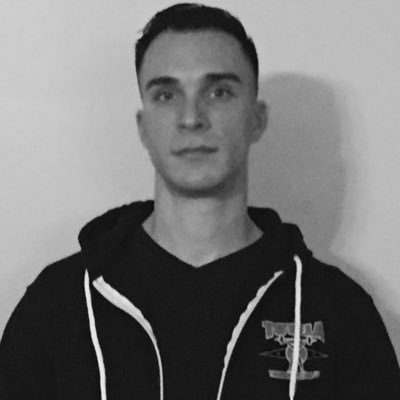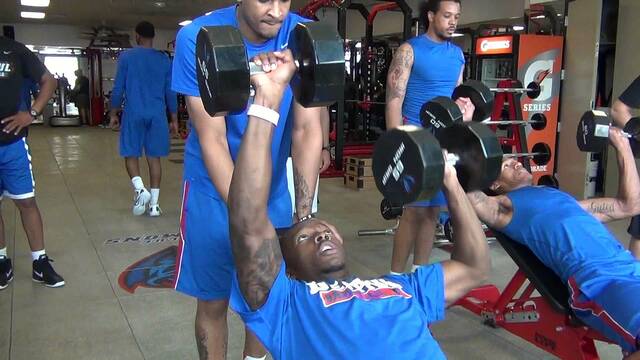The 4 Pillars of High School Basketball Strength and Conditioning
Sports Performance | Strength & ConditioningABOUT THE AUTHOR

Chris Tutela
Chris Tutela is a strength and conditioning coach in Clark, New Jersey. He is the owner and operator of Tutela Training Systems, where he trains mainly athletes and some regular people. He has multiple years experience as a strength coach at the high school level as well a professionally in the private sector.
But what you don’t typically see is the stuff that has stood the test of time: getting athletes strong with blazing speed and explosiveness.
That’s what any athlete needs to be successful. They don’t need the silly stuff that looks cool in a YouTube video. Especially at the high school level.
From my experience working with high level high school basketball players, I’ve found that although these young men are extremely athletic, they are weak and imbalanced.
If we want to take our players’ to the next level, we have to go back to real strength training. And here is how we do that at my facility.

Your Title Goes Here
Your content goes here. Edit or remove this text inline or in the module Content settings. You can also style every aspect of this content in the module Design settings and even apply custom CSS to this text in the module Advanced settings.
1. Focus On Strength First
Training to get strong should be the meat and potatoes of any basketball training template. As with most high school athletes, technique is the biggest flaw. First we need to teach our athletes how to move properly. Teach them how to maintain a neutral spine, squat to parallel, set up properly on a bench press, a dead hang chin-up and to retract and protract the scapula during rows.
They need to understand the basics because strength is your foundation. If their technique sucks their results will be half-assed.
Once your athletes get strong you will notice that everything else will improve. Including their speed, explosiveness and conditioning.
A common mistake I see with some coaches out there is putting a huge emphasis on jumping during their training session. Now don’t get me wrong, basketball players and most athletes need to incorporate jumping into their training. Shit, it’s a necessity.
However, at the high school level if you are not enhancing the athlete’s strength, their power will be sub-par. So don’t waste time trying to improve a young athlete’s power until you develop a solid base of strength.
Which takes me to my next point…
2. Power Development Comes After You've Built a Base of Strength
After your athletes build a foundation of strength you can start to work on their power. Here’s why…
Power = strength x speed
It’s about moving a particular load as fast as possible.
If you’re athlete hasn’t developed strength with proper movement yet, don’t waste time trying to get them more explosive.
Once they do, now it’s time to work power work into your program. Depending on the athlete and how much time you have with them in the off-season, it can take 4-6 weeks (or more in some cases) to see solid improvements in speed and power.
You can approach power development in a few different ways.
You can train with Olympic lifts like cleans and snatches. You can utilize jumps and throws, or you can incorporate both.
In my opinion, incorporating both is the best approach. That is, if you are training your athletes in a private or semi-private setting and have a lot of time to spend working on their Olympic lifts.
You see, Olympic lifts are extremely technical. When they are done correctly they are incredible lifts and are second to none for developing power.
The problem is most coaches work with athletes in a group setting. That type of environment is certainly not the most conducive for getting technical with 14 to 18 year old kids. This usually leads to their athletes using awful technique where not only are they not getting much from the exercise, but they are actually increasing their risk for injury.
If a kid is having a hard time deadlifting with a neutral spine, he sure as hell shouldn’t be trying to clean and snatch.
So, if you are working with a high volume of athletes at a time, I recommend jumping and throwing to develop power.
Vertical jumps, broad jumps, squat jumps, box jumps, med ball soccer throws, sit-up throws and side throws are a few of the different incredible exercises you can use to help your athletes develop power.
They are much easier for your athletes to learn in less time, plus they are significantly safer. Not to mention they are awesome for power development.
If you are working with a lot of athletes at once, it’s a no-brainer in my opinion.

3. Train For Speed
Basketball players need to be fast, and in order to be fast you need to get them on the court or track and work on their speed and acceleration.
The problem is that most coaches confuse speed training with conditioning. They incorporate stuff like “suicides” into what they think is speed training. And that couldn’t be further from the truth. Once you start incorporating conditioning work into a “speed” session you will be working backwards.
When you work on speed that needs to be the focus.
Focus your time on acceleration drills like falling start sprints, prowler marches and mountain climbers into sprints for short distances and timed sprints for 94 feet or less.
Combined with solid foundation of strength and power work your athletes are sure to improve their speed.
4. Conditioning
Finally, in addition to their strength power and speed development (not to mention flexibility and mobility) we have to condition our athletes for their sport. Since that is, in fact, why they are training in the first place.
Basketball is a mixed energy system sport, meaning aerobic and anaerobic. In my opinion, the absolute best way for an athlete to condition is by practicing their sport. There’s just no replacing that.
In a game like basketball, that can be done quite often.
However it’s important to condition your athletes during the offseason both aerobically and anaerobically to build a solid foundation.
I like doing stuff like tempo runs where your athletes will go to a track and sprint the 100 yards then jog the corners for a mile or two.
Bleacher runs are another great tool and easy to execute in a large group setting. Simply sprint up one row then jog down and over to the next row and repeat the process. Start at one end of the bleachers and go down to the other side and back. That’s one. Have them repeat anywhere from 4-6 times depending on the size of the bleachers.
I also like to add in “finishers” to their strength days. We’ll do stuff like mountain climbers, jumping rope, prowler sprints and burpees for a prescribed time, maybe 30 seconds, followed by a rest time of about 60 seconds or so.
Another one of my favorites are hill sprints which we do similarly to the way we do bleacher runs.
Once you tie everything together and create your training template your athletes will get better. Period.
Be sure a major point of emphasis is made on quality technique and programming with a purpose. Once you do that I will guarantee a major change in your team’s performance.
If you have any questions at all, please feel free to email [email protected] and I would be glad to help!
Best of luck this season, guys!
Are you a better coach after reading this?
More coaches and athletes than ever are reading the TrainHeroic blog, and it’s our mission to support them with useful training & coaching content. If you found this article useful, please take a moment to share it on social media, engage with the author, and link to this article on your own blog or any forums you post on.
Be Your Best,
TrainHeroic Content Team
HEROIC SOCIAL
HEROIC SOCIAL
TRAINING LAB
Access the latest articles, reviews, and case studies from the top strength and conditioning minds in the TH Training Lab

